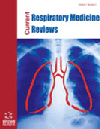- Home
- A-Z Publications
- Current Respiratory Medicine Reviews
- Previous Issues
- Volume 15, Issue 4, 2019
Current Respiratory Medicine Reviews - Volume 15, Issue 4, 2019
Volume 15, Issue 4, 2019
-
-
Nosocomial Pneumonia: An Update on Early Diagnosis and Prevention
More LessAuthors: Artem Kuzovlev, Aslan Shabanov and Andrey GrechkoNosocomial pneumonia and nosocomial tracheobronchitis present a significant problem of anesthesiology and critical care medicine. This review presents the results of our own research on the usefulness of new molecular biomarkers in the early diagnosis of nosocomial pneumonia, as well as modern principles for its prevention. A promising direction for the early diagnosis of nosocomial pneumonia and its complications is the Read More
-
-
-
Role of Noninvasive Positive Pressure Ventilation in Chronic Obstructive Pulmonary Disease
More LessSince 1980, continuous positive airway pressure technology (CPAP) has been one of the most effective treatment methods for obstructive airway disease. About 10 years later, Bi-level Positive Airway Pressure (BiPAP) had been developed with a more beneficial concept. CPAP and BiPAP are the most common forms of noninvasive positive pressure ventilation (NIPPV). CPAP administrates a single, constant, low-pressure air to mai Read More
-
-
-
Evaluation of the Agreement Between the Tissue Sample and Bronchoalveolar Lavage (BAL) Fluid in the Diagnosis of Tuberculosis in Patients with Anthracosis
More LessAuthors: Mohammad Samet, Masoud Rahimian, Samaneh Meshkat and Sanaz ZandBackground: Black dust deposited in the lungs is called anthracosis. By damaging bronchial mucosa, anthracosis can affect the mucociliary cleaning function. Initial reports indicate that there is a relationship between anthracosis and pulmonary tuberculosis. Due to obstructive effects of anthracosis on distal airways and disruption in a proper sampling of bronchoalveolar lavage (BAL), other diagnostic methods are necess Read More
-
-
-
The Impact of Tracheostomy Timing on the Duration and Complications of Mechanical Ventilation
More LessAuthors: Renata d. S. Zaponi, Erica F. Osaku, Lilian Regina Lengler Abentroth, Mayara Manzoni Marques da Silva, Jaiane Luiza Jaskowiak, Suely Mariko Ogasawara, Marcela Aparecida Leite, Cláudia Rejane Lima de Macedo Costa, Itamar Regazzo Pedreschi Porto, Amaury Cezar Jorge and Péricles Almeida Delfino DuarteBackground: Mechanical ventilation is a life support for ICU patients and is indicated in case of acute or chronic respiratory failure. 75% of patients admitted to ICU require this support and most of them stay on prolonged MV. Tracheostomy plays a fundamental role in airway management, facilitating ventilator weaning and reducing the duration of MV. Early tracheostomy is defined when the procedure is conducted up to 10 Read More
-
-
-
Benefits of Pulmonary Rehabilitation in Patients with COPD with Use and without the Use of Supplemental Oxygen During Exercise
More LessObjective: To determine the effects of a pulmonary rehabilitation program in patients with COPD who use and do not use supplemental oxygen during exercise. Materials and Methods: Prospective longitudinal descriptive study on 59 patients with COPD who were part of a pulmonary rehabilitation program and who were classified into two groups: a group that required supplemental oxygen during rehabilitation and an Read More
-
-
-
Risk Factors Associated with Development of Pulmonary Arterial Hypertension and Corpulmonale in Patients with Chronic Obstructive Pulmonary Disease
More LessBackground: Chronic Obstructive Pulmonary Disease is an important cause of morbidity and mortality globally. The onset of pulmonary hypertension and corpulmonale is associated with decreased survival in patients with COPD. Objective: To assess risk factors associated with the development of pulmonary hypertension and corpulmonale and to identify high-risk phenotypes who may need early evaluation and inte Read More
-
-
-
Pulmonary Rehabilitation Effects on Heart Rate Recovery in Restrictive Lung Disease Patients
More LessObjective: The study aimed to evaluate heart rate recovery in subjects with restrictive lung disease (RLD) and healthy age matched subjects before and after a rehabilitation program (RP). Methods: This is a cross-sectional study on subjects of both genders, with over 40 years old with and without any diagnosis of restrictive lung disease and who were able to perform physical tasks were included in the study. They were eval Read More
-
-
-
Airway Obstruction in a Cancer Patient: Is it Always Cancer?
More LessAuthors: Nicholas Hinds, Amit Borah, Kathy Morrow, Jeffrey Hoag and Emil AbramianAllergic Bronchopulmonary Aspergillosis (ABPA) is a common hypersensitivity to Aspergillus sp. that is well described in the literature. The populations most susceptible to developing this reaction are asthmatics and patients with cystic fibrosis (CF). The presenting symptoms can vary as ABPA is rarely described in otherwise normal individuals, however, in patients with an underlying familial predisposition to atopy, it can b Read More
-
-
-
Resolution of Empyema Thoracis after Patient Refusal of Surgical Intervention: A Case Series and Review of the Literature
More LessParapneumonic effusions occur commonly in patients hospitalised with pneumonia. Both complicated parapneumonic effusions and empyema are often managed initially with tube thoracostomy and intrapleural t-PA and DNase. If complete expansion of the lung is not achieved, surgical intervention is considered. We present three cases of patients with complicated parapneumonic effusions who experienced complete re Read More
-
Volumes & issues
-
Volume 21 (2025)
-
Volume 20 (2024)
-
Volume 19 (2023)
-
Volume 18 (2022)
-
Volume 17 (2021)
-
Volume 16 (2020)
-
Volume 15 (2019)
-
Volume 14 (2018)
-
Volume 13 (2017)
-
Volume 12 (2016)
-
Volume 11 (2015)
-
Volume 10 (2014)
-
Volume 9 (2013)
-
Volume 8 (2012)
-
Volume 7 (2011)
-
Volume 6 (2010)
-
Volume 5 (2009)
-
Volume 4 (2008)
-
Volume 3 (2007)
-
Volume 2 (2006)
-
Volume 1 (2005)
Most Read This Month
Article
content/journals/crmr
Journal
10
5
false
en


